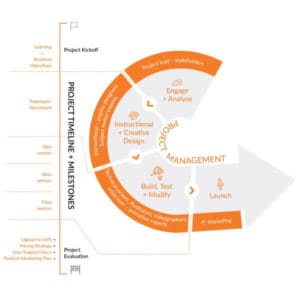Articulate
7 Articulate Examples That Inspire Creativity in Online Courses
Creating engaging online courses is an art. It requires creativity, innovation, and the right tools....
Read MoreDigital learning is here to stay. A great way for non-profits to connect and educate members and supporters is to create on-demand learning opportunities. It provides the convenience that busy people are demanding. And it provides superior results over traditional training. But most non-profits aren’t experts in creating online learning. Don’t worry. Below are 13 simple ways you can improve your on-demand learning courses. And educate your members and supporters to further your mission.
“Digital learning is the quickest growing market in the education industry, with a whopping 900% growth since 2000.”
KPMG
On demand, learning is a self-paced training experience delivered through an electronic medium. One that the learner accesses whenever and wherever they decide to. Often online and accessed via a phone, tablet, or laptop.
Examples of on-demand learning include
Remember the time when people used to rush home to sit in front of the television at the same time each week and watch the latest episode of their favorite show? Nowadays that never happens. With on-demand and streaming content, you cue up your show at whatever time is convenient for you. Even sports fans often watch an event later in the day.
“58% of employees prefer self-paced learning over instructor-led learning.”
And it’s the same with training. People no longer schedule their training months in advance. Nor do they make travel and accommodation arrangements. Instead, they log in and access it on-demand whenever they want. The benefits of on-demand learning are many and include the following:

“Online learning provides fantastic flexibility, among other benefits, and aids in making the task of arranging development opportunities far easier. In addition, the ability for users to have access to content when needed provides the just-in-time element that is so critical.”
Dr. Sharon Jones, CEO & Founder of The Dottie Rose Foundation
When an organization designs on-demand 
“I would ask you to question who’s at the table and who’s not at the table and to think about those voices that aren’t represented when you’re making decisions.”
JAMES HALLIDAY, Board Chair at Emerging Practitioners in Philanthropy
Many non-profit organizations assume that they have to give things away for free. But if you provide a valuable experience, then you can charge for your on-demand learning. And people will be willing to pay a reasonable price for that value. As well, having a cost associated with your online learning elevates it in the mind of your learner. They see the cost as a sign that this has a higher value than a free item. We’ve worked with many non-profits and designed on-demand learning for them, which they sell. The learning they provide furthers the mission and you can invest more from the proceeds of the courses. As well you can consider offering two prices for a course. One is the standard price, and the other is the standard price along with an extra donation towards the cause.
Having a good delivery platform can make a huge difference. For the learner, it can greatly impact their learning experience. Does the learning technology platform create a group of confused, frustrated learners? Or an engaged group who had no trouble navigating the learning process? On demand learning is an investment in helping you reach your mission. Using a ‘free’ delivery technology might seem good at first. But you have to factor in the extra costs and time of paying for workarounds. And the potential for creating a poor experience for the learner. Having a good delivery platform can also have extra benefits. For example, one of our clients developed a course for volunteers on their learning platform. And immediately saw the potential for other uses. Such as employee onboarding, board director training, as well as extra external audiences they could reach.
“The students of the future will demand the learning support that is appropriate for their situation or context. Nothing more, nothing less. And they want it at the moment the need arises. Not sooner, not later. Mobile devices will be a key technology for providing that learning support.”
Dr. Marcus Specht, Professor of Advanced Learning Technologies, Open University of Netherlands.
Build it and they will come is not a good marketing strategy. If you want people to take your on-demand course they need to know it exists and the value that they will get out of it. So, you need a marketing plan. This could include an email campaign to your members/supporters. Or advertising on your website and social media platforms. Perhaps some google ads too? If you want people to find your on-demand learning by doing an internet search you’ll need to invest in some search engine optimization (SEO). And content marketing. If you don’t know what those are then you need to hire some experts who can help you. There’s no point in spending money on developing your on-demand learning, only for no one to know it exists.
We’ve worked with many non-profits who have secured funding through a variety of grants for the creation of on-demand learning. The funder loves it if you can create a revenue stream by selling your training or education. And don’t be afraid to ask for help in writing a grant proposal. We’ve helped many non-profits secure funding by using our expertise to describe what should be developed, at what cost, and what the deliverables will be.
“Leaders become great not because of their power but, because of their ability to empower others.”
John Maxwell
It’s critically important that you understand
Actively search for partnerships. This is something that non-profits are often better at than for-profit organizations. If there are organizations that you could partner with, explore options that benefit both parties. This could include cost-sharing AND revenue sharing. For example, if you have a great course, that other organizations don’t have why not team up with them? You could have a ‘white label’ version that they offer to their subscribers. Or if you are focused on one area and other organizations serve different areas, then you might find it beneficial to partner up.
As resources are precious it makes sense to test the concept of your on-demand learning before you proceed with building it. Create a “spec sheet” that describes the course, what value it offers, why people should take it, and what they will get out of the course. Use this to gauge the reaction and feedback from people in your target audience. And build in their feedback to create a better product.
“The growth and development of people is the highest calling of leadership.”
Harvey S. Firestone
You need to follow a proven plan and 
Although you’re a non-profit you will still benefit from using business tools and methods. You may not be familiar with some of them but the instructional design company you hire should be. And they can guide you through them to develop a superior online course. You might hear terms such as business model canvas. Or value proposition, customer development framework, market research tools, or keyword analysis. Go with the flow and enjoy learning some new concepts along the way. We’ve used these and more with our non-profit clients in developing on-demand learning solutions.
Rather than starting from scratch to build your on-demand learning, are there assets you already have that you could use? For example, if you have recorded webinars on some of the topics in your course, you can use these. For example, by taking portions of the recorded webinars and adding in new instructional aspects. You can create simple on-demand learning at a modest cost.
The traditional approach of building and then launching when it’s perfect often isn’t the best approach. As you work through the process it’s far better to test and confirm your ideas and work as you go. Often, we will have a stakeholder group to get feedback on important aspects. This helps you understand the market and identify valuable features for your potential users. And it can give you realistic insight into pricing expectations and help you clarify your positioning.
“The reason why online learning is useful is that everyone learns in their unique way, at their own pace. People can be inconvenienced by attending a workshop and may get intimated by more extroverted participants. However, with online learning, employees can go through topics and soak in information at their speed.”
Grant Aldrich, Founder & CEO of OnlineDegree.com
Measuring the effectiveness of your on-demand learning is a key step. You need to know how well your learners understand and can apply what they’ve learned. So, include an assessment, or a series of them throughout the online learning program to tell you how well they understand the material.
When creating your evaluation also think of it as gaining insights into what your learner finds valuable. Ask questions that can help you improve your course. Or that identify the potential for future on-demand learning options. And you can use evaluation comments as testimonials and as part of your “sales copy”. As well you could build in ways to find out how they are using what they’ve learned in their life or work. What are the changes they’ve made as a result of the course? A follow-up email or random interviews can also give you insights into the effectiveness of your on-demand learning.
Online learning has been growing rapidly in recent years. After Covid19 its growth has been exponential. But most non-profits aren’t experts in creating online learning. Even though it’s a great way for non-profits to connect and educate their members and supporters using on-demand learning opportunities. But now you have 13 simple ways to improve your on-demand learning to educate your members and supporters to further your mission.
At Spark and Co., we work with many 